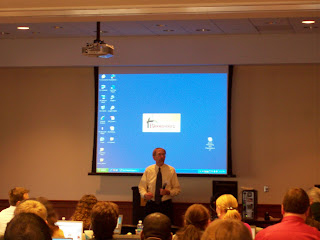Today student's present their mock solution to a mock exercise as part of their Master's of Science in Instructional Technology degree requirement. It is a great event. Students have written a 40 page proposal, created a 20 minute "sales" presentation and are prepared for a 15 minute question and answer session from our corporate advisory council members (we have over 30 in attendance this semester).
Here is a brief overview of the Request for Proposal to which they've responded this semester (it changes every semester.)
Mock E-Learning RFP Fall 2009
This semester the focus is on developing a “Training System” for the introduction of a new product from Big Power Tool Company (BPTC). The RFP has opportunities for product training, sales training, e-learning, hands-on instructor-led elements, multiple languages and follow up training. As well as training geared toward experts and novices and the opportunity for students to offer a solution using Web 2.0 and social media solutions.
Introduction
The purpose of this semester’s Request for Proposal is to have the students submit a proposal to design and develop a training system for the launch of a new hardware product aimed at three markets, retail “big box” stores, independent hardware stores and professional contractors. The new combo tool kit will revolutionize the hand tool market and allow for the powering through of work with less fatigue and all day run time.
The kit contains a Drill/Driver, an Impact Driver, a Reciprocating saw, one Work light, one Charger and two Interchangeable Lithium-ion Batteries. The training systems must encompass the needs of both experienced sales representatives and a field force of new representatives who have not previously sold our products before.
Additionally, the instruction must be in three different languages, English, French and Spanish.
About the Client
Big Power Tool Company, Inc. (BPTC) is an international manufacturer and marketer of quality power tools and accessories, hardware and home improvement products focused on making the construction and building of residential and commercial properties easier and more efficient. They are well known for the Model Z drill line and their innovative approach to new product design and development as indicated by our being awarded the IDEAS 5.0 Innovation Award for six consecutive years. BPTC’s products and services are marketed in more than 100 countries, and they have manufacturing operations in fifteen countries.
Objectives Students Need to Fulfill
The objectives of the work BPTC wishes to commission are:
· To design, develop and deliver a training system (no longer than 5 days) that provides sales representatives (both novice and experienced) with the product knowledge and sales approach necessary to sell the SUPER MAX Combo into the three markets.
· The training system must include initial training and then follow up training exercises, techniques or approaches that continually coach the sales representatives and alert them to competitor responses in the market. (This is the opportunity for social media solutions).
· Create both online and hands-on learning events within the overall system for the time frame.
· Create the system in three languages.
The event has over 40 CAC members in attendance.
Jason introduces himself and tells the year
he graduated from the program.
First Team: Stellar Strategies
Liz, Michael, Joe, Nitin and Susan of
Stellar Strategies discuss their solution.
Joe discusses the prototype.
Susan presents her "close."
Team answers questions from CAC members.
Student Team Global Talk
Elaine, Romona, Tony and Dion.
Showing how the training process
flows with a short automated piece.
Global Talk addressing the training
needs of Big Power Tool Company.
Student Team MicroManage
Eric, Rachel, Michelle and Adam present their solution.
Rachel outlines the solution for BPTC.
Adam discusses the prototype.
Written Winner: MicroManage
Presentation Winner: Global Talk
Prototype Winner: Stellar Strategies
MicroManage wins overall.
Throughout the day, I will post pictures and overviews of the student presentations. Also, you can follow the tweets with the #BUCAC hash tag.
(student presentations will not be streamed.)
__
Catalog of Recommended Books, Games and Gadgets
Recommended Games and Gadgets
Recommended Books
Content Guide

















































